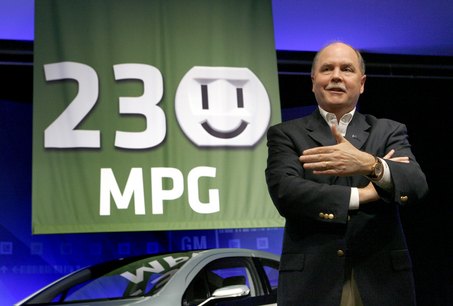2 Views
Quote Of The Day II: 230 MPG "May Be Overly Optimistic?" Edition
by
Edward Niedermeyer
(IC: employee)
Published: September 30th, 2009
Share
Official fuel economy testing for all vehicles is conducted on chassis dynamometers, which are basically treadmills for cars and trucks. One subtlety of chassis dynamometer testing is that vehicle fuel economy measurements using decades-old standard speed profiles may be overly optimistic compared to today’s average on-road fuel use. Official methods exist to adjust the test cycle fuel economy of conventional vehicles to better estimate expected real-world fuel use, but a similar adjustment method has yet to be finalized for PHEVs.From a National Renewable Energy Lab paper on plug-in hybrid efficiency testing [via Green Car Congress].
Edward Niedermeyer
More by Edward Niedermeyer
Published September 30th, 2009 6:58 PM
Latest Car Reviews
Read moreLatest Product Reviews
Read moreRecent Comments
- SCE to AUX All that lift makes for an easy rollover of your $70k truck.
- SCE to AUX My son cross-shopped the RAV4 and Model Y, then bought the Y. To their surprise, they hated the RAV4.
- SCE to AUX I'm already driving the cheap EV (19 Ioniq EV).$30k MSRP in late 2018, $23k after subsidy at lease (no tax hassle)$549/year insurance$40 in electricity to drive 1000 miles/month66k miles, no range lossAffordable 16" tiresVirtually no maintenance expensesHyundai (for example) has dramatically cut prices on their EVs, so you can get a 361-mile Ioniq 6 in the high 30s right now.But ask me if I'd go to the Subaru brand if one was affordable, and the answer is no.
- David Murilee Martin, These Toyota Vans were absolute garbage. As the labor even basic service cost 400% as much as servicing a VW Vanagon or American minivan. A skilled Toyota tech would take about 2.5 hours just to change the air cleaner. Also they also broke often, as they overheated and warped the engine and boiled the automatic transmission...
- Marcr My wife and I mostly work from home (or use public transit), the kid is grown, and we no longer do road trips of more than 150 miles or so. Our one car mostly gets used for local errands and the occasional airport pickup. The first non-Tesla, non-Mini, non-Fiat, non-Kia/Hyundai, non-GM (I do have my biases) small fun-to-drive hatchback EV with 200+ mile range, instrument display behind the wheel where it belongs and actual knobs for oft-used functions for under $35K will get our money. What we really want is a proper 21st century equivalent of the original Honda Civic. The Volvo EX30 is close and may end up being the compromise choice.


































Comments
Join the conversation
That's the whole reason mpg is listed on the sticker- so you can determine operating cost. 18 mpg 10 years ago means something totally different than today, and means somethind different in Japan than in the US, but it is still 18 mpg no matter when and where they are. This is because the context changed. Would you rather the number be fixed at 1979 dollars per $.85/gal 1979 gas? The same 18 mpg car in 1979 would rate at 21.2 miles per dollar, and today it would be 7.2 miles per dollar with NO CHANGES othe than the cost of gas and the value of the dollar. Furthermore, that car will get 18 mpg whether the gas is expensive gas in Japan or cheap gas in Saudi Arabia, but the miles per dollar would be dramatically different. The dollar changes too much, and the price of electricity and fuel are too variable for this to be a useful, published measure. Remember when diesel was more than gas recently? Could you imagine having to go check the miles per dollar of your car every few days? Just tell us the efficiency, and the energy providers will tell you the price of the fuel. Of course, the volt is even using miles per dollar since that is entirely dependent on the length of your trip. They're making it even more confusing. On top of all that, to truly be miles per dollar, you'd have to consider the insurance, operations, and maintenance cost of your car. What you really need to know to make comparissons is a car's energy efficiency and the cost of that energy FOR YOU. A blanket label for this will be correct for almost NOBODY.
It's really, really simple. Three rules: ------------- 1. If You Have More Than One Distinct Drive Mode, You Get More Than One Sticker. 2. Everything That's On One Sticker Goes On The Other(s). 3. All Units Of Fuel Consumption Should Be Presented In Terms Of The Fuel(s) Actually Used, With "Consumption" Relative To The Moment The User First Acquires The Fuel(s). ------------- So, if you normally would have a sticker that says "30mpg city/36 mpg hwy/500 miles per tank", and you make that into a series-style plug-in hybrid, you now have two stickers: one that says "30mpg city/36 mpg hwy/500 miles per tank", and one that says "200 Wh/mi city/260 Wh/mi hwy/40 miles per charge" (with the Wh/mi being wall to wheels, not pack to wheels) I don't see why anyone would possibly want any other kind of measurement. Why wouldn't you want all the info from one sticker for each distinct drive modes your vehicle has? Why wouldn't you want your units in terms of when you acquire the fuel (I.e., wall-to-wheel energy efficiency instead of pack-to-wheel energy efficiency)? How could you possibly make an informed decision with everything lumped together into a contrived "mpg" rating that has no reflection on how you'll actually drive the car?